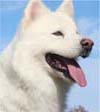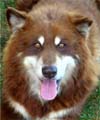|
Home
About Giant
Alaskan Malamutes
Our Giant Malamutes
The Adults
Giant Alaskan Malamute
Puppies Available
Giant Alaskan Malamute
Past Puppies
Policies/Pricing
FAQ
Alaskan Malamute
Links
Contact MalAMail
Malamute Postcards




 

|
Hudson's Malamutes - Frequently Asked Questions
13. What do you recommend for training?
Puppy Kindergarten, Puppy Kindergarten, Puppy Kindergarten
No, that is not a broken record, but my very best recommendation for training :)
If you choose not to go this route (and I'm not sure why, because you're making it harder on yourself in my opinion), I do have some recommendations below.
However, these are only supplemental to what you will learn in Puppy Kindergarten locally and in person (always preferable to calling long distance to me - it's very hard for me to recommend specific training methods when I can't see you or your puppy or the interaction between you - a competent local trainer can catch things for you very quickly).
Puppy Kindergarten is the first step in formal training. Pups must have basic socialization skills with other dogs and with many people to help them become well-mannered dogs. This is a fun, positive experience for the pups and owners, and helps condition them to accept more formal training later.
Local PetSmarts often offer Puppy Kindergarten classes, as do more progressive Veterinary Practices, and local dog trainers.
One of my pup's mom, kept a journal of their Puppy Kindergarten Experiences, which gives you an idea of the fun and learning that goes on in these classes.
Patient consistency is the key in training. Just as humans aren't born with a high-school diploma and take some time to learn, puppies also take some time to learn.
Also see Your New Puppy FAQ
Housebreaking
Just as human babies don't come out of the womb toilet trained, puppies do not come out of the womb house-broken.
Use the crate training (pdf) method for your pup. Also see Crating Your Dog FAQ and A Guide to Crate Training Your Dog. When you can't supervise them, they should be crated. You will need a crate, washable bathmats (for the crate 'bedding'), toys, water supply. Very quickly your pup will learn not to eliminate in their crate, because that is their home. Take the leashed pup outside when you first let them out of the crate and walk around with them until they pee and poop. Praise them for doing so. Eventually, they will associate outside as the proper place to pee and poop. When they have accidents, do not rub their nose in it. If you observe them having an accident, give a sharp, lower-voiced "No" and take them outside. If you do not observe the accident, just clean it up and say nothing. Correction must be instant to the offense or they do not know for what they are being corrected. They may look guilty, but only because of the tone of your voice. Praise must also be instant, so that it is associated with good behavior.
Tips
- Take the puppy outside immediately after it awakens in the morning and after all naps
- Excitement produces a lot of pee and poop! When play produces excitement, or meeting new people produces excitement, take them outside for a pee break.
- Puppies only know convenience at the start of their little lives. If they gotta go, they go. Always watch for signs (walking around sniffing the floor etc) they need to go, and get them outside immediately. Outside then becomes convenient.
Here's a list of Not Recommended:
- Do not take the puppy to bed with you, let them sleep in their crate
- Do not use puppy pads
Start housebreaking using the above method instantly. You will pay for using puppy pads, even if for a day or two because the pup will remember that it was ok to go in that area. If it's not going to be okay later, don't start it at all
- Do not give up the crate after a month.
Puppies are not housebroken in a month or even two. Continue crate training, even if you think your puppy is completely housebroken.
You can purchase large, extra large and giant crates at your local PetSmart or online at
PETsMART.com
No Biting/Nipping
Teething pups try to bite everything, and those little milk teeth are sharp as needles. They are not biting because they are aggressive, but because they are teething.
However, a pup needs to know that his teeth on human flesh is unacceptable.
Methods for curbing this behavior as recommended by Puppy Kindergarten trainers:
- Wear sox, don't leave those tempting wriggling toes in pup eyesight
- When your puppy is in teething mode, keep your face away from his
Puppies are just playing and do not realize they can hurt you with those milk teeth.
Don't set them up for failure, but do things that set them up for success.
- In firm lowered voice say, "no bite" and remove your hands/arms from the pup (put them behind your back)
- In firm lowered voice say, "no bite" then turn your head and leave the room (this imitates a mother dog ignoring a misbehaving pup). Puppies do not like to be ignored.
- In firm lowered voice say, "no bite" and give them a 10 minute time out in their crate. When you let them out, DO NOT bend down and make happy sounds, just let them out and don't make a big deal of it. Making happy sounds can get them cranked up and into misbehaving again.
- Have a good supply of greenies, nyla bone healthy edibles and chew toys for them. Stick one in their mouth when they go to nibble on you. But do be sure they have something to gnaw on.
- Another method is to yelp out (as if hurt - whether or not you are) when puppy nips. Based on the training their mother gave them, they will back off. Mother dogs train their pups not only to back off if causing a sibling or her pain, but also the "soft bite". The "soft bite" is what you see when dogs are playing - no one gets hurt.
- With stubborn pups, put the puppy on their back, hold their mouth closed with your hand, kneel over them, and in loud lowered voice (while showing your teeth) say "no bite". Do not let them up until they are submissive to you.
This imitates what a mother dog does to a misbehaving puppy.
In some puppies, this will just crank them up, if that is the case, don't do this again.
- Get yourself and your puppy immediately into Puppy Kindergarten and see these methods in action, hear all the same stories from other puppy owners (so you know you are not alone) and learn even more methods.
Remember, correction must be instant to the offense or they do not know for what they are being corrected. They may look guilty, but only because of the tone of your voice. Praise must also be instant, so that it is associated with good behavior.
Howling/screaming during the night
- Using the crate training method, you may initially and then occasionally hear your pup howl to get out. IGNORE IT! They will get over it.
- Whatever you do, DO NOT GIVE IN TO THEM, or you set back their training (and yours in being a dog owner).
- They will get over it, and will very quickly learn to sleep through the night, and eventually not eliminate during the night.
- Some veterinarians recommend initially going to bed an hour early, so that the initial howling may start sooner, but it will end sooner and you will get the sleep you need.
- Remember, as stated further up, you should have toys in their crate (especially a stuffed toy for them to sleep with).
- Some people recommend keeping an audible ticking clock nearby, as it simulates the sound of their mother's heartbeat, and is soothing to them.
Formal Training:
Puppy Kindergarten is the first step in formal training. Pups must have basic socialization skills with other dogs and with many people to help them become well-mannered dogs. This is a fun, positive experience for the pups and owners, and helps condition them to accept more formal training later.
Local PetSmarts often offer Puppy Kindergarten classes, as do more progressive Veterinary Practices, and local dog trainers.
One of my pup's mom, kept a journal of their Puppy Kindergarten Experiences, which gives you an idea of the fun and learning that goes on in these classes.
The next step in formal training is Basic Obedience, which covers sit/stay, down/stay, leash training (heeling), focus on the owner despite distractions, and more..
Local PetSmarts often offer Basic Obedience, as do more progressive Veterinary Practices, and local dog trainers.
After that, formal training depends on the direction you want to take your dog.
- CGC - Canine Good Citizenship
this AKC program is designed to reward dogs who have good manners at home and in the community
- Obedience
- Sledding
- Weight pulling
- Agility
- Skijoring
- Packing
- Tracking
- Rally
- Showing
Remember that you are training your pup, every day! Don't allow behavior now that you do not want in an adult dog. Don't ignore bad behavior, that is the same as accepting the behavior.
Reinforce good behavior with praise and treats.
Patient, consistency is the key - hardwork, but rewarding with the resulting well-mannered adult Malamute.
|

